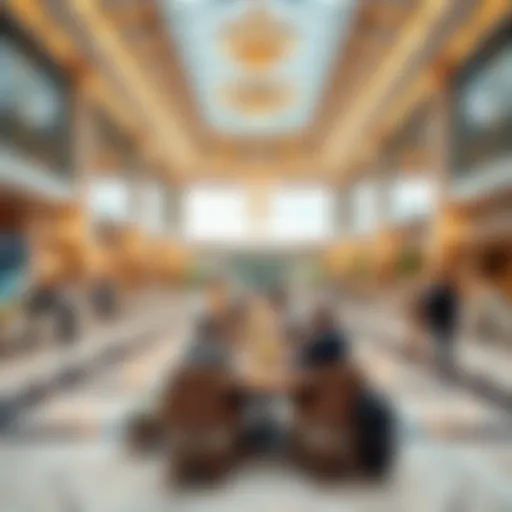Exploring دوار الساعة: History, Architecture, and Culture
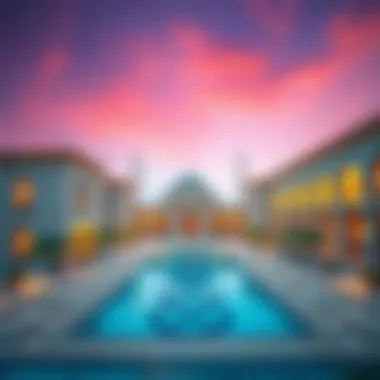

Intro
دوار الساعة, or the Clock Roundabout, stands not just as a physical landmark but as a symbol woven into the fabric of Dubai’s identity. This exploration aims to peel back the layers surrounding its significance, yet it does not merely rest on aesthetics or historical footnotes. Instead, it seeks to connect the dots between its architectural marvel and the cultural heartbeat of the city. This piece will engage investors, brokers, expatriates, and buyers alike, offering rich insights into the current dynamics of Dubai's real estate and culture while examining the broader impact of دوار الساعة on urban life.
Market Trends
In understanding any landmark, especially one as pivotal as دوار الساعة, it's crucial to delve into the market trends that frame its context. The vicinity around دوار الساعة has evolved dramatically, mirroring the economic currents of Dubai.
Current Market Analysis
Over the past few years, the area surrounding دوار الساعة has experienced a spike in interest from real estate investors. As both a tourist magnet and a residential hub, the prime real estate has attracted influx investments. Prices have surged as buyers recognize the potential for value appreciation in this bustling region. Key factors driving this interest include:
- The landmark's central location, which provides access to a myriad of services and amenities.
- Significant infrastructural developments around the roundabout, enhancing transportation links and connectivity.
- The cultural and historical allure of the site, making it a focal point for both locals and tourists alike.
These elements have transformed دوار الساعة into a haven for searchers of both commercial and residential properties, offering vibrant opportunities for investors.
Future Projections
Looking forward, anticipation shrouds the دوار الساعة area, as projections suggest continued growth and development. Analysts foresee:
- An increase in property values owing to ongoing urban expansion and infrastructural projects.
- The expansion of commercial enterprises, likely due to heightened tourism and consumer interest.
- A potential bump in foreign investment, fueled by Saudi and Emirati directives that encourage affluent buyers from nearby regions.
Investment experts advocate keeping a keen eye on the movements around دوار الساعة, as the implications of market trends could spell substantial opportunities for forward-thinking investors.
Investment Opportunities
Beyond understanding market dynamics, it's pivotal to dive into specific investment opportunities that have emerged from دوار الساعة’s unique landscape.
High-Growth Areas
Some neighborhoods and properties adjacent to دوار الساعة stand out, positioning themselves as hotspots for confident investors:
- Al Rigga: Known for its vibrant atmosphere, this area is slowly becoming a residential landmark that offers competitive pricing alongside cultural charm.
- Deira City Centre: Just a stone's throw from دوار الساعة, this commercial area continues to thrive as a shopping destination—appealing greatly to investors looking for retail stakes.
Key Investment Strategies
As the landscape continues to shift, investors may consider several strategies when engaging with properties near دوار الساعة:
- Buying into upcoming developments: Focusing on new projects that promise future returns can be particularly rewarding
- Long-term rentals: Given the high demand for housing in this lively sector, properties that can be leased out attract solid returns.
- Collaborative ventures: Partnering with local businesses to create mixed-use spaces could fester community and yield profits.
Ultimately, as the pulse of Dubai continues to beat steadily, those who engage with دوار الساعة strategically may find themselves at the forefront of the city’s urban renaissance. The foresight is not merely a luxury; it’s a commitment to participating in a dynamic ecosystem ripe for growth.
For further insights into the cultural and economic landscapes that shape دبي, you can visit sources like Wikipedia, Britannica, and Reddit. Keeping up-to-date with these resources can enhance understanding as you navigate the intricacies surrounding دوار الساعة and the larger Dubai area.
Prolusion to دوار الساعة
The دوار الساعة, commonly known as the Clock Roundabout, stands as a pivotal emblem of modern Dubai. It is not just a roundabout; it is a place of convergence, where cultures and histories meet, symbolizing the rapid development of the city into a global hub. This section sets the stage for our exploration into its multifaceted characteristics. By delving into the origins and significance of دوار الساعة, we aim to unpack the layers of cultural and architectural context that surround this landmark.
Origin and Meaning
The roots of دوار الساعة are deeply intertwined with Dubai’s journey from a humble fishing village to a bustling metropolis. Established in the late 1960s, it was designed to embody a vision of progress and modernity. The name itself—"دوار الساعة"—translates to "Clock Roundabout", indicative of its function as a timekeeper within the city's lively pace. The clock within the roundabout is more than just a mechanism to tell time; it serves as a reminder of the relentless advancement of the region, capturing the spirit of a society that embraces change while respecting its heritage.
Beyond mere functionality, the دوار الساعة speaks volumes about the societal shifts and ambitions of the Emirati people. It symbolizes a collective aspiration for growth, drawing visitors and residents alike to its unique blend of tradition and modernity.
Location and Accessibility
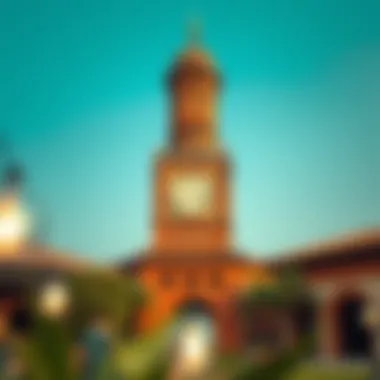
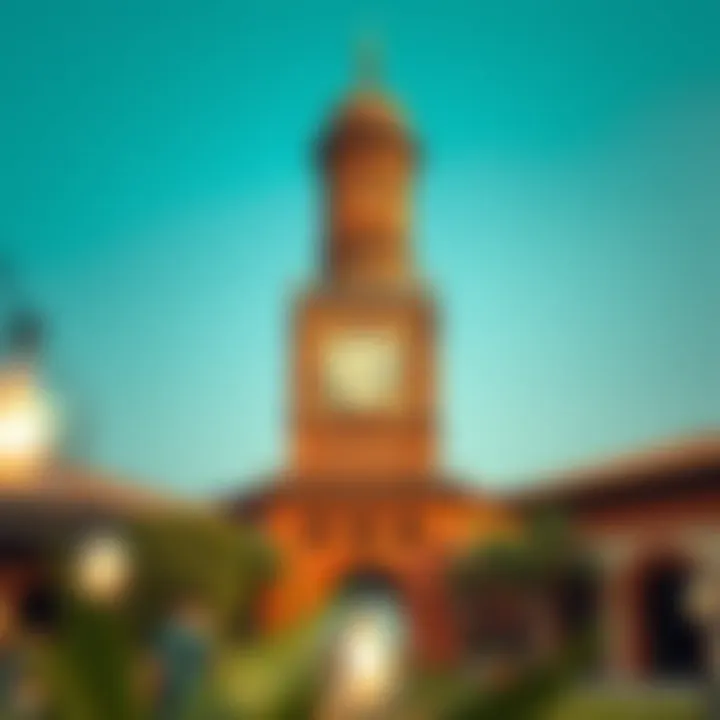
Situated at the crossroads of vital roadways in Dubai, دوار الساعة boasts excellent accessibility, making it a landmark that is easily reachable for both residents and tourists. It lies at a strategic point connecting the bustling areas of Deira and Bur Dubai, areas rich in history and commerce.
The surrounding landscape is peppered with commercial establishments, making it a hive of activity throughout the day. Visitors can conveniently access it through public transport options, including the Dubai Metro which has nearby stations. Additionally, well-maintained roadways ensure that driving to the دوار الساعة is straightforward.
Such accessibility amplifies its significance, positioning it as a central point for gatherings and events, thus reinforcing its role in the urban fabric of Dubai.
In summary, the دوار الساعة is not a mere geographical marker; it is a monument narrating the story of Dubai's growth, cultural significance, and commitment to future progress. As we venture further into the article, we will examine the historical context and architectural characteristics, further illuminating the unique identity of this landmark.
Historical Context
The historical context serves as the backbone of any exploration into the دوار السا�عة, shedding light on how this remarkable landmark evolved over time. Understanding its historical significance not only enriches the narrative surrounding its existence but also reveals the cultural and social fabric of Dubai itself. The intricacies of its journey from conception to its current stature reflect broader trends and shifts in both urban development and Emirati identity.
Evolution of دوار الساعة
The journey of دوار الساعة is intertwined with the rapid growth of Dubai as a global city. Initially conceived in the late 1990s, the project aimed to create a central focal point in the bustling district of Deira. The evolution is marked by careful planning and foresight, as the landmark was designed to symbolize the city’s emergence as a nexus for trade and tourism.
In its early days, the structure began as a simple clock tower, strategically placed to captivate both locals and visitors alike. As the urban landscape transformed around it, so did its role within the community. The clock tower became not just a spot for telling time but a gathering place for social interaction, a point of orientation for navigation, and a testament to the aspirations of a nation eager to carve a prominent place on the world stage.
Key Milestones
Several key milestones define the history of دوار الساعة, marking its importance through different phases:
- 1999 - Construction Initiation: The groundwork was laid, setting the tone for what would become a key architectural feature of the city.
- 2000 - Official Opening: The clock tower was inaugurated, injecting a sense of pride into the local populace and increasing the city's visibility to the outside world.
- 2005 - Cultural Symbol: The دوار الساعة began to be recognized beyond its functional use, becoming a symbol of Emirati heritage and modernity.
- 2010 - Urban Revitalization: Surrounding areas underwent extensive developments, increasing foot traffic and further embedding the clock tower into the fabric of daily life.
The دوار الساعة's journey is a reflection of Dubai's transformation—a story of ambition, aspiration and the beauty of architectural expression.
Through these milestones, the دوار الساعة transitioned from a mere timekeeping mechanism to a landmark that embodies the spirit of Dubai’s relentless pursuit of progress. Today, it stands not only as a celebrated structure but as a reminder of the innovative spirit that has defined the Emirati identity over the years.
Architectural Characteristics
The architectural characteristics of دوار الساعة are not just about aesthetics; they reveal a deeper narrative about the identity of modern Dubai. Understanding these characteristics gives insights into how the landmark integrates with the surrounding environment, serves its functional purpose, and represents the cultural ethos of the region. The architectural design reflects both a rich heritage and a forward-thinking vision, making it a centerpiece in the urban landscape of Dubai.
Design Elements
The design of دوار الساعة is particularly striking due to its unique blend of traditional Arab design and modern architectural innovation. At the heart of its form lies the iconic clock tower, reaching high into the sky, serving not just as a timepiece but as a beacon of progress. The roundabout's open spaces allow for fluid movement, making it not just a pedestrian thoroughfare but a social gathering spot as well.
Key features include:
- Elegant Architectural Lines: The sweeping curves and geometrical shapes invite the eye, drawing people closer while skillfully integrating with the layout of the area.
- Layered Facades: These create dynamic shadows and highlights throughout the day, illustrating the time of day in an almost theatrical manner.
- Centrally Located Fountain: A notable design element that adds a sense of tranquility to the bustling activity of the roundabout. The sound of water brings a serene oasis feel amidst the urban chaos.
These design elements play an essential role in the overall experience of دوار الساعة, enhancing its visual appeal and encouraging both locals and tourists to engage.
Materials Used
When it comes to construction, the materials selected for دوار الساعة exemplify durability and visual significance. The choice of materials reflects local culture while also standing the test of time against Dubai's harsh climate.
- Locally Sourced Stone: This not only provides strength but also connects the structure to the geological makeup of the UAE, grounding it within its physical landscape.
- Glass and Steel: Employed for contemporary accents, these materials exhibit transparency and lightness that stand in contrast to the mass of the stone elements. They allow for reflections of surrounding skyscrapers, thus creating a dialogue with the modernity of Dubai.
- Sustainable Options: The inclusion of energy-efficient materials and systems demonstrates a commitment to sustainability, ensuring that the architecture supports eco-friendly practices moving forward.
Each material has been thoughtfully chosen to enhance the structure’s longevity and resonance within the local context.
Symbolism and Aesthetics
Beyond mere functionality, the architectural characteristics of دوار الساعة are steeped in symbolism. The clock tower serves as a metaphor for the passage of time and the rapid development of the UAE. This is particularly poignant in a city known for its rapid transformation and innovation.
- Cultural Identity: The blend of traditional Islamic art motifs with contemporary architecture captures the essence of a nation that honors its roots while embracing the future.
- The Clock as a Symbol: Represents not just the literal concept of time, but signifies the importance of progress, both socially and economically. It stands as a reminder of how far the region has come in a relatively short period.
- Artistic Expression: The interplay of colors, shapes, and forms contributes to the overall aesthetic appeal, making the roundabout not just a functional public space, but also a canvas of artistic expression.
In summary, the architectural characteristics of دوار الساعة are multifaceted, and they encapsulate the spirit of Dubai’s urban identity. Understanding these aspects enhances appreciation for the landmark's role, which not only serves as a navigational point but also as a cultural touchstone that reflects the vibrancy of life in the UAE.
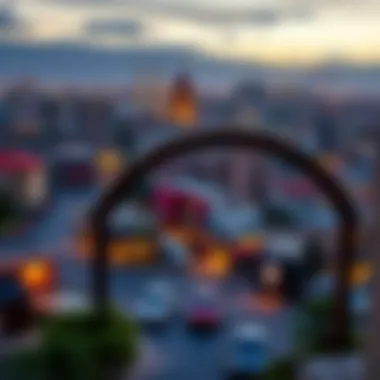
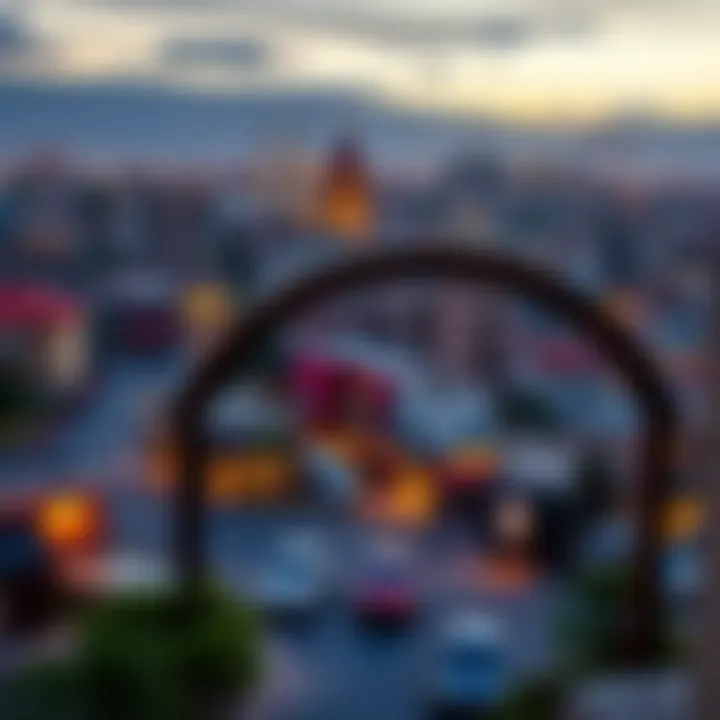
Cultural Significance
The cultural significance of دوار الساعة is profound, stretching across various facets of Emirati identity and community. This landmark has become a touchstone for both locals and visitors alike, symbolizing the blend of tradition and modernity that characterizes Dubai. As you stroll through the surrounding area, it becomes clear that دوار الساعة is more than just a monument—it is a representation of the Emirati soul.
دوار الساعة in Emirati Culture
In the heart of Emirati culture, دوار الساعة serves as a meeting point, fostering social interactions among people of all ages. Families gather around it during public celebrations such as Eid, national holidays, and various cultural festivals. It stands not just as a clock tower, but as an emblem of community spirit, where stories are shared, laughter is exchanged, and memories are forged. The landmark also highlights the importance of time in Emirati lives, reflecting a society that values punctuality and tradition, alongside modern aspirations.
In recent years, the site has even been integrated into local art and literature. For instance, several Emirati poets and writers draw upon دوار الساعة in their works, illustrating its role as a cultural beacon. Schools often organize trips here, ensuring that younger generations appreciate its historical context and cultural meaning. The pride associated with this landmark is palpable, and its influence extends deep into the collective consciousness of the Emirati people.
Artistic Representations
The artistic representations of دوار الساعة are as diverse as the Emirati culture itself. From intricate murals in local cafes to digital art pieces displayed during exhibitions, this landmark has inspired numerous forms of creative expression. Artists often use دوار الساعة to symbolize the passage of time, linking it to themes of heritage, progress, and identity.
Local artists, for instance, sometimes showcase their work at nearby galleries, presenting reinterpretations of دوار الساعة that breathe new life into the traditional forms. These pieces often combine vibrant colors and modern techniques with influences from Islamic art traditions, creating a bridge between the past and contemporary expressions.
Moreover, photography plays a significant role in capturing the essence of دوار الساعة. It has become a popular subject for both amateur and professional photographers, often showcasing its stature against the striking Dubai skyline. This captured imagery not only promotes the landmark but also highlights its importance as a cultural touchstone, particularly among expatriates and tourists who seek to connect with the local culture.
"دوار الساعة is not just a place; it’s a canvas where stories and emotions blend into the vibrant tapestry of Emirati life."
The cultural footprint of دوار الساعة continues to expand as it engages people from all walks of life, drawing attention from art enthusiasts, history buffs, and casual travelers alike. As the world evolves, so too does the significance of this landmark—remaining firmly rooted in the heart of Dubai's identity, while inviting new interpretations and understanding.
Economic Impact
The economic impact of دوار الساعة cannot be overstated; it serves as more than just a visual landmark in Dubai. This section explores how this grand structure influences local businesses and real estate developments, interwoven with the fabric of the urban landscape. The interplay of economic dynamics around such iconic sites is crucial for understanding the broader implications for growth and opportunity within the emirate.
Influence on Local Businesses
Local businesses thrive in proximity to دوار الساعة. The area surrounding this landmark is bustling with various enterprises, from small coffee shops to major retail outlets. The constant influx of tourists and residents alike generates a steady stream of income for these establishments.
- Increased Foot Traffic: The high volume of visitors ensures a vibrant commercial atmosphere. For example, cafes such as the Arabian Tea House or the Dubai Mall Café benefit from people drawn to the area for sightseeing.
- Diverse Offerings: Businesses are not just selling souvenirs or traditional artifacts; there are also modern shops catering to younger crowds. Technology stores offering the latest gadgets or fashion boutiques catering to trendsetters illustrate this diversity.
- Job Creation: As businesses flourish, they inevitably create job opportunities, ranging from entry-level positions to managerial roles, helping to reduce unemployment in the area.
Real Estate Developments Nearby
The economic significance of دوار الساعة extends seamlessly into the real estate sector. It has directly influenced several key developments nearby, enhancing their market value and attractiveness. The presence of this landmark plays a core role in real estate decisions for investors and developers.
- Rising Property Values: Properties in close proximity to دوار الساعة typically command higher prices. Real estate firms, such as Emaar Properties, have seen success in projects nearby, due, in part, to the attraction of the landmark.
- Mixed-Use Developments: Developers are increasingly focusing on mixed-use projects that integrate residential, commercial, and recreational spaces. Projects like Dubai Creek Harbor exemplify how developers leverage the popularity of notable sites for sustained growth.
- Urban Revitalization: The area continues to evolve with modern infrastructure and facilities, driven by urban planners’ vision. It is not just about building new structures; it often involves restoring and enhancing existing ones to draw more interest from residents and tourists.
This intersection of دوار الساعة with local businesses and real estate developments highlights its crucial role in shaping economic landscapes.
Tourism and دوار الساعة
Tourism plays an essential role in the economic and cultural fabric of Dubai, with دوار الساعة standing as a beacon for visitors from around the globe. Its towering presence not only marks the passage of time but also the convergence of local heritage and modernity, making it a focal point for tourists seeking to experience the rich tapestry of the Emirati landscape. The importance of دوار الساعة as a tourist attraction can't be overstated, as it captures both the imagination and the hearts of those who visit.
Role as a Tourist Attraction
دوار الساعة is a symbolic landmark that serves as more than just a point of interest; it embodies the spirit of Dubai's rapid development and cultural evolution. Various elements contribute to its allure:
- Cultural Heritage: It showcases traditional Islamic architecture fused with contemporary design, emblematic of Dubai’s cultural respect and modern growth.
- Central Location: Positioned within a bustling city square, it is surrounded by restaurants, shops, and cafes. This strategic placement encourages foot traffic and activities around the clock.
- Events and Festivals: دوار الساعة often acts as the backdrop for local festivities, celebrations, and cultural events, drawing in crowds and creating a festive ambiance.
By highlighting these features, the landmark positions itself as a key player in Dubai's tourism sector, attracting not only tourists but also those interested in the city’s economic landscape.
Visitor Experience
When visitors approach دوار الساعة, they are greeted by an enriching experience that combines visual splendor with engaging activities. The experience of visiting this landmark can be delineated into several facets:

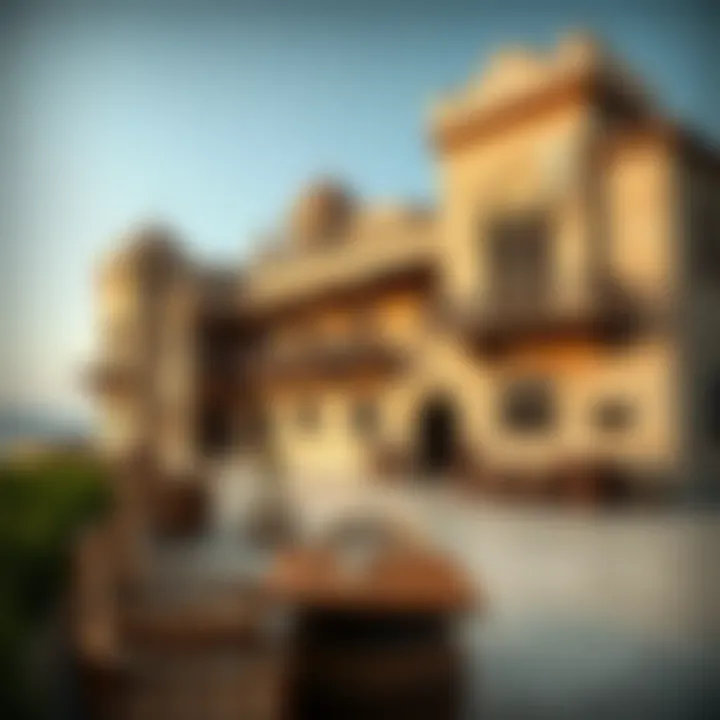
- Visual Impact: The hourglass design and the massive clock face leave an impression that resonates with visitors. Many pause to admire the intricate details, capturing photographs to immortalize their visit.
- Cultural Insights: Guided tours often offer insights into the history and significance of the structure, providing a deeper understanding of its context within Emirati culture. Enthusiasts may find local stories and legends surrounding the landmark captivating.
- Dining and Leisure: Nearby cafes serve everything from traditional Emirati dishes to international cuisine, providing options for visitors to relax post-exploration and soak in the local atmosphere.
- Shopping Opportunities: The vicinity is home to a plethora of shops and markets, offering souvenirs and goods that reflect the region's rich cultural heritage.
In summary, the visitor experience at دوار الساعة is meticulously curated to engage all senses, making it a compelling destination for tourists seeking more than just a photograph. It is this blend of culture, architecture, and vibrant atmosphere that secures its place as a must-see when exploring Dubai.
Current Infrastructure and Urban Integration
The integration of دوار الساعة into the broader urban framework of Dubai is more than just a matter of location; it speaks to how cultural landmarks can act as anchors within a sprawling metropolis. As Dubai continues to evolve with its rapid pace of urbanization, understanding the current infrastructure surrounding this landmark is essential. A strong infrastructure contributes to accessibility, safety, and the overall experience of the landmark itself.
Surrounding Developments
When we talk about the surrounding developments around دوار الساعة, we find a robust mix of commercial and residential projects that contribute to the vibrancy of the area. This bustling square is flanked by a variety of structures, including hospitality venues, shopping centers, and residential towers. For example, the Renaissance Downtown Hotel and the Dubai Mall are both just a stone's throw away, drawing tourists and locals alike. The presence of such establishments increases foot traffic and creates a lively atmosphere, making دوار الساعة a focal point for both leisure and commerce.
Moreover, the urban landscape surrounding the clock tower integrates public transport access effectively. The newly constructed metro line offers a seamless connection to various parts of the city, allowing for easy navigation. This strategic planning not only enhances the visitor experience but also sets the stage for future growth, as more urban planners and investors see potential in the vicinity.
Urban Planning Considerations
Urban planning in Dubai is characterized by a forward-thinking approach that marries tradition with modernity. For دوار الساعة, this implies ensuring that any further developments respect its historical significance while also accommodating the rising population and the burgeoning tourism sector. Urban planners must carefully evaluate zoning laws and building regulations to maintain a balanced vision for the area without compromising its character.
One consideration is the implementation of green spaces that enhance the aesthetic appeal of the urban environment. Parks and plazas can serve not only as a respite for the citizens but also as venues for cultural events and community gatherings, further embedding دور الساعة in the social fabric of Dubai.
Additionally, handling traffic flow in such a high-density area poses challenges. Effective traffic management strategies are fundamental to avoiding congestion, which could deter visitors. Measures, such as dedicated pedestrian lanes and efficient public transit options, can facilitate smoother movement around this landmark.
In summary, the current infrastructure and its urban integration around دوار الساعة illustrate the connection between a city’s past and its aspirations. This approach doesn’t just beautify an area; it adds an enduring value that attracts investors, tourists, and residents alike. As Dubai continues to evolve, maintaining this balance becomes crucial for preserving the historical significance of landmarks while also meeting contemporary needs.
Future Prospects
The future of دوار الساعة holds considerable significance not only for its architectural and cultural implications, but also for the broader urban landscape of Dubai. As a focal point of the city, planning for its continued development is paramount. Investors, brokers, and expatriates should note that the growth trajectory of nearby real estate and businesses can be closely tied to the landmark's evolution.
Plans for Development
Development plans around دوار الساعة are ambitious and are increasingly based on sustainable practices that align with Dubai’s vision for future urbanity. Current initiatives include integrating smart city technologies that enhance the visitor experience and accessibility.
- Smart Infrastructure: Plans include the introduction of interactive digital kiosks, which would provide real-time information about the landmark and surrounding attractions. This technological enhancement could greatly increase foot traffic.
- Green Spaces: The establishment of nearby parks and gardens aims to make the area more inviting. Such spaces not just beautify the surroundings, but serve to cool the urban heat island effect that typically accompanies extensive urbanization.
- Public Transportation Integration: Efforts to enhance public transport options around دوار الساعة can greatly affect its connectivity. A proposed new metro line is likely to increase accessibility, ensuring that both locals and tourists can enjoy the landmark more easily.
- Cultural Activities and Events: Organizing local festivals or cultural events in the vicinity will further elevate دوار الساعة's status, transforming the landmark into a hub of social interaction and community involvement.
Potential Challenges
As promising as the plans for دوار الساعة are, they do not come without challenges.
- Urban Congestion: With increased development, there's a real concern about traffic and pedestrian congestion in the area. Balancing increased visitors with local traffic flow might be a tough nut to crack.
- Maintaining Historical Integrity: As the area develops, ensuring the preservation of the historical essence of دوار الساعة presents a unique challenge. Striking a balance between modernization and conservation requires careful attention to detail and extensive consultation with cultural experts.
- Economic Fluctuations: The broader economic climate can impact investment levels. Potential downturns in the economy may hinder the ambitious plans laid out, impacting both development and local businesses that depend on tourism and visitor spending.
- Environmental Concerns: As the push for development intensifies, there may rise concerns regarding environmental impact. Sustainable practices must be prioritized to avoid jeopardizing Dubai's already delicate ecosystem.
Ultimately, while the road ahead for دوار الساعة is paved with opportunity, it is equally fraught with challenges that stakeholders need to navigate carefully. A concerted effort from urban planners, investors, and the community will ensure that this landmark not only stands the test of time but flourishes well into the future.
Ending
The conclusion of this comprehensive exploration into دوار الساعة serves as a critical nexus where all elements of the discussion converge. It encapsulates the essence of the iconic landmark, bringing insights from its historical depth, architectural brilliance, cultural significance, and economic impact into a cohesive narrative. Understanding this landmark is not merely an academic exercise; it offers strategic advantages to various stakeholders, particularly investors, brokers, expatriates, buyers, and researchers.
Summary of Key Insights
In striking contrast to a fleeting tourist attraction, دوار الساعة represents a vibrant touchstone for the city’s ongoing evolution. Here are the core takeaways:
- Historical Significance: Serving as a barometer for Dubai’s rapid development, دوار الساعة reflects both tradition and modernity. Its construction symbolizes the ambitions of a city with grand aspirations.
- Architectural Features: The design merges functional aesthetics with cultural motifs, integrating local craftsmanship with modern engineering. Each stone tells a story, from design elements to the choice of materials, which all contribute to its unique charm.
- Cultural Ties: Beyond being just a landmark, دوار الساعة acts as a cultural crossroads, hosting events and gatherings that strengthen community bonds and celebrate Emirati heritage.
- Economic Influences: The landmark is a catalyst for real estate developments and has a marked impact on local businesses, driving growth potential in a bustling urban environment.
Final Thoughts
As Dubai continues to ascend on the global stage, دوار الساعة stands not only as a reminder of where the city has come from but also as a beacon guiding its future. The interwoven threads of history, culture, and economic progress make this landmark a microcosm of Dubai itself.
In a world that constantly seeks authenticity, دوار الساعة invites localized experiences and engagement, paving the way for future developments and innovations. Stakeholders would do well to acknowledge the significance of this site, as its influence will likely persist, affecting both the tangible and intangible aspects of Dubai’s urban fabric.
A thorough understanding of دوار الساعة resonates deeply, highlighting how such landmarks are not just points on a map but integral layers in the city’s rich narrative.
"Everything has beauty, but not everyone sees it." - Confucius
The UAE’s dynamic future may well hinge on how its historical landmarks like دوار الساعة are preserved, appreciated, and integrated into urban planning and cultural narratives. Continued exploration and insight into such facets only promise more gripping tales of innovation and growth.



